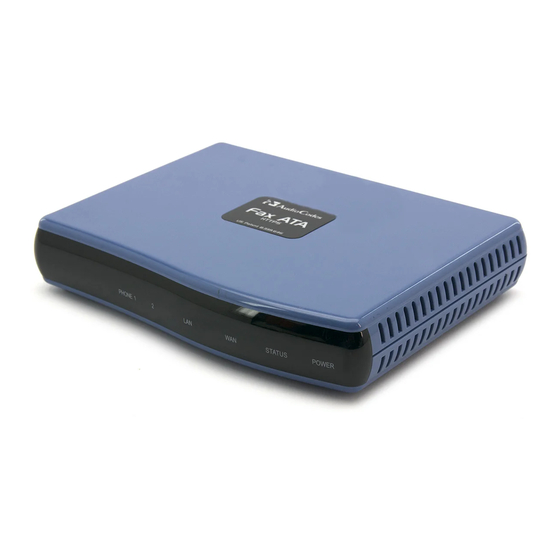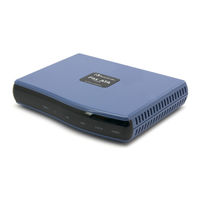
AudioCodes MP-20x Manuals
Manuals and User Guides for AudioCodes MP-20x. We have 2 AudioCodes MP-20x manuals available for free PDF download: User Manual
AudioCodes MP-20x User Manual (270 pages)
MediaPack MP-20 Series Telephone Adapters with Integrated Router
Brand: AudioCodes
|
Category: Adapter
|
Size: 4 MB
Table of Contents
-
-
-
-
Qos Wizard71
-
-
DSCP Mapping80
-
Mapping82
-
-
-
-
General Tab88
-
Settings Tab89
-
Wireless Tab90
-
Advanced Tab104
-
-
-
10 WAN Settings
105-
WAN Ethernet105
-
Settings Tab106
-
Routing Tab108
-
Advanced Tab109
-
WAN Pppoe110
-
General110
-
PPP Tab111
-
DNS Server113
-
Routing113
-
-
Wan Pptp114
-
Document #: LTRT114
-
General117
-
PPP Encryption117
-
DNS Server118
-
Routing118
-
Wan L2Tp118
-
General120
-
DNS Server121
-
PPP Compression121
-
PPP Encryption121
-
Routing121
-
-
-
-
Settings Tab125
-
Routing Tab128
-
Advanced Tab129
-
LAN-WAN Bridging136
-
Settings Tab140
-
Bridge Tab140
-
-
-
-
Overview151
-
-
-
Snmp171
-
Syslog174
-
Telnet CLI176
-
-
13 Security
177-
-
Access Control180
-
Port Forwarding182
-
DMZ Host185
-
Port Triggering186
-
Nat192
-
Connections196
-
Security Log200
-
-
-
-
About the MP-20X210
-
Certificates210
-
-
DNS Server222
-
Diagnostics224
-
Firmware Upgrade226
-
-
DHCP Connections234
-
MAC Cloning235
-
Network Objects236
-
Pppoe Relay237
-
Dynamic DNS238
-
Protocols241
-
Reboot242
-
Routing246
-
S Cheduler Rules248
-
Snmp250
-
System Settings252
-
Date & Time254
-
Advertisement
AudioCodes MP-20x User Manual (346 pages)
CPE & Access Gateway Products, Multimedia Home Gateway
Brand: AudioCodes
|
Category: Adapter
|
Size: 6 MB
Table of Contents
-
-
-
Set Commands54
-
-
-
-
WAN Ethernet66
-
-
-
-
Qos Wizard116
-
-
-
-
-
Dhcp143
-
LAN Connection147
-
LAN Ethernet147
-
General Tab148
-
Settings Tab148
-
Advanced Tab150
-
Routing Tab150
-
-
-
WAN Connection151
-
General Tab151
-
Settings Tab152
-
Routing Tab156
-
PPP Tab158
-
PPTP Tab160
-
Advanced Tab161
-
-
VLAN Settings162
-
Settings Tab165
-
Routing Tab168
-
Advanced Tab169
-
-
-
Print Server178
-
Print Protocols180
-
-
Overview201
-
-
-
Snmp227
-
Syslog231
-
Redirect Server232
-
Telnet CLI232
-
Default Behavior234
-
-
15 Security
237-
Configuring NAT253
-
-
17 Home Media
283 -
-
19 Media Sharing
295 -
20 Maintenance
299-
Firmware Upgrade314
-
-
Running Debug328
-
Running Tcpdump331
Advertisement
Related Products
- AudioCodes MewdiaPack MP-202
- AudioCodes MediaPack MP-202B
- AudioCodes MediaPack MP-203B
- AudioCodes MediaPack MP-201B
- AudioCodes MediaPack MP-202C-A
- AudioCodes MediaPack MP-201B1FXS
- AudioCodes MediaPack MP-201BSIP
- AudioCodes MediaPack MP-202B2FXS
- AudioCodes MediaPack MP-204BSIP
- AudioCodes MediaPack MP-203BSIP

